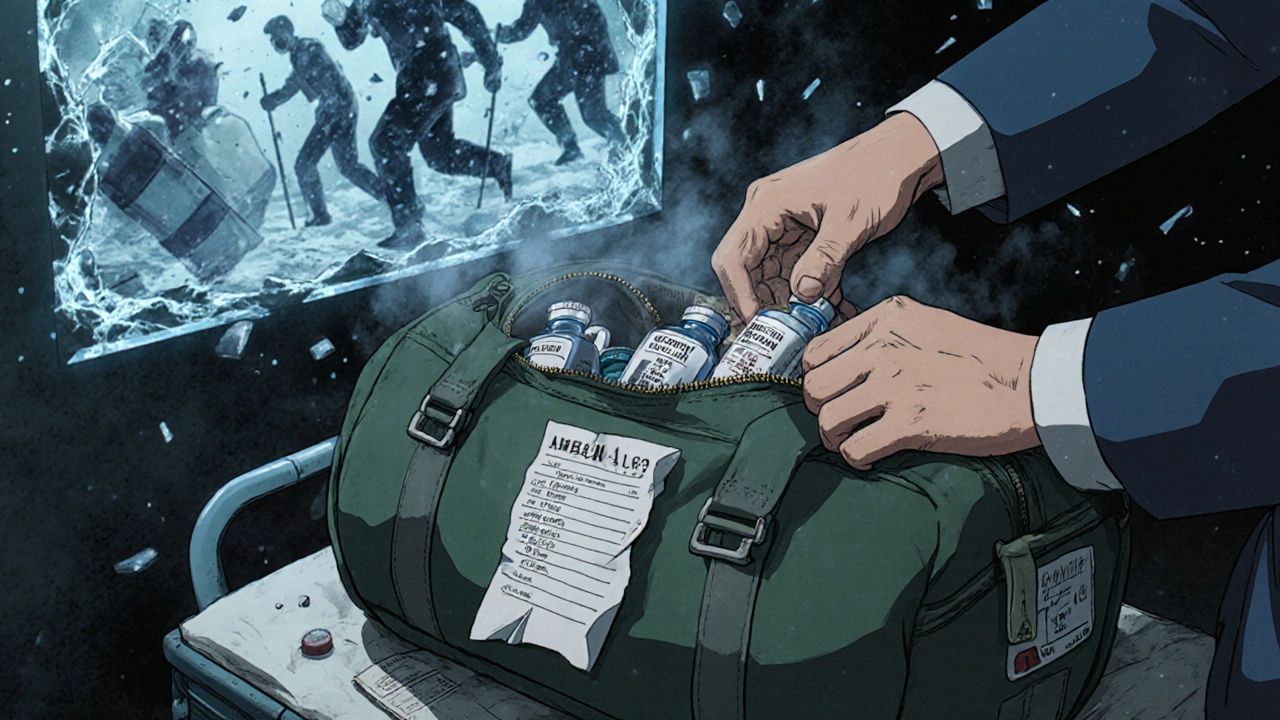When a disaster strikes-whether it’s a flood, wildfire, or power outage-you won’t have time to hunt for your pills. Your blood pressure medication, insulin, or asthma inhaler might be sitting in a cabinet you can’t reach, or worse, sitting in a house you can’t return to. That’s why a simple, well-packed medication go-bag can be the difference between staying stable and ending up in the ER during a crisis.
Why Your Go-Bag Needs Medications First
Most people think of water, flashlights, and canned food when preparing for emergencies. But if you take regular medication, your body doesn’t care about the storm outside-it still needs its pills on schedule. The CDC reports that 89% of Americans over 65 take at least one prescription drug. Even younger people with conditions like diabetes, epilepsy, or heart disease rely on daily meds to survive. Interrupt that supply, even for a day, and serious health crashes can happen. A 2022 FEMA report after Hurricane Ida found that 23% of evacuees ran out of medication. Of those, 31% were missing cardiovascular drugs, 22% were out of respiratory meds, and 18% had no insulin. These aren’t just inconveniences-they’re life-threatening gaps. Emergency rooms see a 38% spike in visits during disaster recovery, and nearly a third of those cases are tied to missed doses.What to Put in Your Medication Go-Bag
You don’t need a fancy kit. Just a sturdy, water-resistant bag-like a backpack or small duffel-that you can grab in seconds. Here’s exactly what belongs inside:- A 14-day supply of all prescription medications-This is the new standard. While the Red Cross says 7 days, agencies like Alert San Diego and the CDC now recommend two weeks. Why? Disasters don’t always end in three days. Roads stay blocked. Pharmacies stay closed. You might be stuck longer than you think.
- Original prescription bottles-Don’t dump pills into random containers. Keep them in their labeled bottles. Emergency responders need to know exactly what you’re taking, the dosage, and who prescribed it.
- A printed medication list-Write down: drug names, dosages, frequency, reason for use (e.g., “Lisinopril 10mg once daily for high blood pressure”), and your doctor’s name and number. Include allergies and past reactions.
- Over-the-counter essentials-Pain relievers (acetaminophen or ibuprofen), antihistamines, anti-diarrheal meds, and antacids. These aren’t optional. You’ll need them if you’re stressed, eating unfamiliar food, or dealing with minor injuries.
- Medical devices-If you use an inhaler, nebulizer, glucose monitor, or epinephrine auto-injector, pack extra batteries, test strips, and spare parts. Don’t forget your insulin pump or CPAP machine if you rely on one.
- Emergency contact card-Name, phone, and relationship of your primary doctor, pharmacist, and a trusted family member. Include your insurance ID number and any advance directives like a DNR order.
Special Cases: Refrigerated and Sensitive Medications
Not all pills can survive a hot car or a power outage. Insulin, some biologics, and certain antibiotics need to stay cool. If you take these, your go-bag isn’t complete without a cooling solution. The Frio Wallet-a reusable, water-activated cooling pack-has been tested by Consumer Reports to keep insulin below 86°F for up to 48 hours. It’s lightweight, fits in a pocket, and costs less than $30. For longer trips, consider the MedAngel ONE, a small sensor that connects to your phone and alerts you if your meds overheat. It’s FDA-cleared and works even without Wi-Fi. Never leave insulin in direct sunlight or in a car during summer. Even if it looks fine, heat can break down the molecules. Expired insulin doesn’t just stop working-it can cause dangerous spikes in blood sugar.
How to Keep Your Go-Bag Fresh
A go-bag you packed last year is useless if everything expired. Medications don’t last forever. Even if the bottle says “expires in 2027,” heat and humidity can degrade them faster. Here’s how to stay on top of it:- Rotate every 3 months-Every time you refill a prescription, swap the oldest pills in your go-bag with the new ones. Use a “first in, first out” system.
- Check expiration dates monthly-Set a phone reminder. Look at each bottle. If it’s within 3 months of expiring, replace it.
- Ask your pharmacist for larger supplies-Many states allow pharmacists to give you a 90-day supply instead of 30. Ask if you can get extra for your go-bag. Some even offer free emergency refill programs.
- Store it right-Keep your go-bag in a dry, cool place-like a high shelf in your bedroom closet. Avoid the bathroom (too humid) or the garage (too hot or cold).
Documentation: The Silent Lifesaver
In the chaos of an emergency, you might not be able to speak. That’s why your written info matters more than anything. One woman in Florida, caught in a flash flood, was rushed to a hospital unconscious. Her go-bag had a laminated card listing her diabetes, insulin allergies, and her doctor’s number. The ER team avoided giving her a drug that would’ve caused a deadly reaction. She woke up three days later, alive, because someone took the time to write it down. Your documentation should include:- Full name, date of birth
- Emergency contacts (two people, with phone numbers)
- Allergies (list reactions: rash, swelling, trouble breathing)
- Chronic conditions (diabetes, heart failure, COPD, etc.)
- Current medications (name, dose, time taken)
- Primary care physician and pharmacy info
- Insurance card copy

Who Needs This Most?
It’s not just seniors. People of all ages rely on daily meds:- Diabetics-Need insulin, glucose monitors, test strips
- People with heart disease-Take blood thinners, beta-blockers, diuretics
- Those with asthma or COPD-Require inhalers, nebulizers, oxygen
- People on mental health meds-Antidepressants, antipsychotics, anti-anxiety drugs
- Patients on dialysis or with kidney disease-Need strict fluid and electrolyte control
What to Do If You Can’t Get Your Meds
If you’re stranded and out of pills, don’t panic. In 42 states, pharmacists can legally give you an emergency 7-day supply without a new prescription if you have proof you were taking the drug-like an empty bottle or your go-bag’s list. Call your pharmacy first. If they’re closed, go to any open pharmacy and show your documentation. Emergency responders and shelters often have basic meds on hand, but they can’t replace your specific prescription.Start Today. No Excuses.
You don’t need to buy a $200 pre-made kit. Start with what you have:- Grab a bag you already own.
- Take out your three most critical meds and put them in.
- Write down their names and doses on a sticky note.
- Next time you refill a prescription, add an extra week’s supply.
Do I need to carry all my meds in my go-bag, even if I don’t take them daily?
Only pack medications you take regularly-daily or multiple times a week. Skip ones you take only occasionally, like antibiotics for a past infection. Focus on what keeps you stable right now. If you’re unsure, ask your pharmacist.
Can I use pill organizers in my go-bag?
Yes, but only as a supplement. Always keep the original prescription bottles in your go-bag too. Pill organizers help with daily use, but emergency responders need the full label info. Use organizers for convenience, not replacement.
What if my medication needs refrigeration and I lose power?
Use a Frio Wallet or similar cooling pack. These don’t need electricity-they activate with water and keep insulin cool for up to 48 hours. Keep one in your go-bag and another at home. If you’re in a shelter, ask if they have a fridge you can use.
Should I include vitamins or supplements in my go-bag?
Only if they’re medically necessary-like high-dose vitamin D for someone with osteoporosis or B12 for a vegan with deficiency. General multivitamins aren’t critical. Prioritize life-sustaining medications first.
How often should I check my go-bag?
Check it every 3 months. Look for expired pills, damaged packaging, or wet containers. Replace anything that’s past its date. Set a calendar reminder for the first day of each season.

Liam Strachan
Really solid guide here. I’ve been meaning to put together a med go-bag ever since my neighbor got stuck without insulin during that power outage last winter. Just grabbed a small waterproof pouch and tossed in my blood pressure pills, a printed list, and my doctor’s info. Took me 10 minutes. Best 10 minutes I’ve ever spent.
Nosipho Mbambo
Okay, but… why 14 days? That’s… excessive. Who’s gonna be stuck for two weeks? I mean, really? In 2024? We have drones, Uber, and WhatsApp. If you can’t get meds in 7 days, maybe you shouldn’t be living in a disaster zone?!!
Katie Magnus
OMG I’m so done with this ‘prepper’ nonsense. Like, I’m not a diabetic, I’m not old, and I don’t live in a hurricane zone. Why do I need to carry pills like I’m preparing for the apocalypse? This is fear-mongering dressed up as ‘safety.’ 🙄
Jeremy Samuel
fr tho, who even has time to rotate meds every 3 months? i just keep em in my bathroom cabinet and hope for the best. also, ‘frio wallet’? sounds like a bad fanfic title. lol
Destiny Annamaria
Y’ALL. I’m a single mom with asthma and I’ve been carrying my inhaler in my purse since my kid was born. But this? This is the first time I’ve thought about packing my insulin pen and glucose strips too. I’m gonna do it tonight. Thank you for this. I’m not alone in this. 💪❤️
Ron and Gill Day
This is a textbook example of over-engineering a problem. The CDC? FEMA? Please. If you’re relying on a plastic bag of pills to survive a disaster, you’ve already lost. Real preparedness means moving to a safer location. Or at least learning to live without drugs.
Alyssa Torres
Destiny here-just got back from volunteering at a shelter after the Texas storms. I saw a man with a go-bag like this. He had his insulin, his pump, a backup battery, and a laminated card with his doctor’s number. When the ER was overwhelmed, he didn’t have to wait. He stayed stable. That’s not luck. That’s planning. And you? You can do this too. Start with one pill. One list. One bag. You got this.
Summer Joy
So… you’re telling me I need to carry my anxiety meds in a bag… but I can’t carry my trauma in a bag? 😭 This is so performative. Like, I’m supposed to feel safe because I have a Frio Wallet? What about the fact that I can’t afford my meds in the first place? This post is tone-deaf and privileged. 🤡
Aruna Urban Planner
From a public health systems perspective, the structural gap here is not individual preparedness, but systemic pharmaceutical access. While the go-bag is a pragmatic micro-solution, the macro-inequity lies in prescription affordability, supply chain fragility, and lack of national emergency pharmaceutical protocols. One cannot ‘prepper’ their way out of policy failure. Still, the go-bag is a necessary interim adaptation.
Kristi Bennardo
It is unacceptable that the average American must carry their life-sustaining medication in a duffel bag. This is not preparedness-this is a national failure of healthcare infrastructure. I will not be lectured on ‘rotating pills’ while insurance companies deny refills and pharmacies charge $400 for a 30-day supply. This post is a bandage on a severed artery.
Shiv Karan Singh
LOL. You think your Frio Wallet saves lives? I’ve seen people die with 30 days of insulin in their bag… because they didn’t know how to use it. This is just a distraction. Real solution? Universal healthcare. Or at least, stop telling poor people to ‘just pack a bag’ while their meds cost more than their rent. 🤦♂️